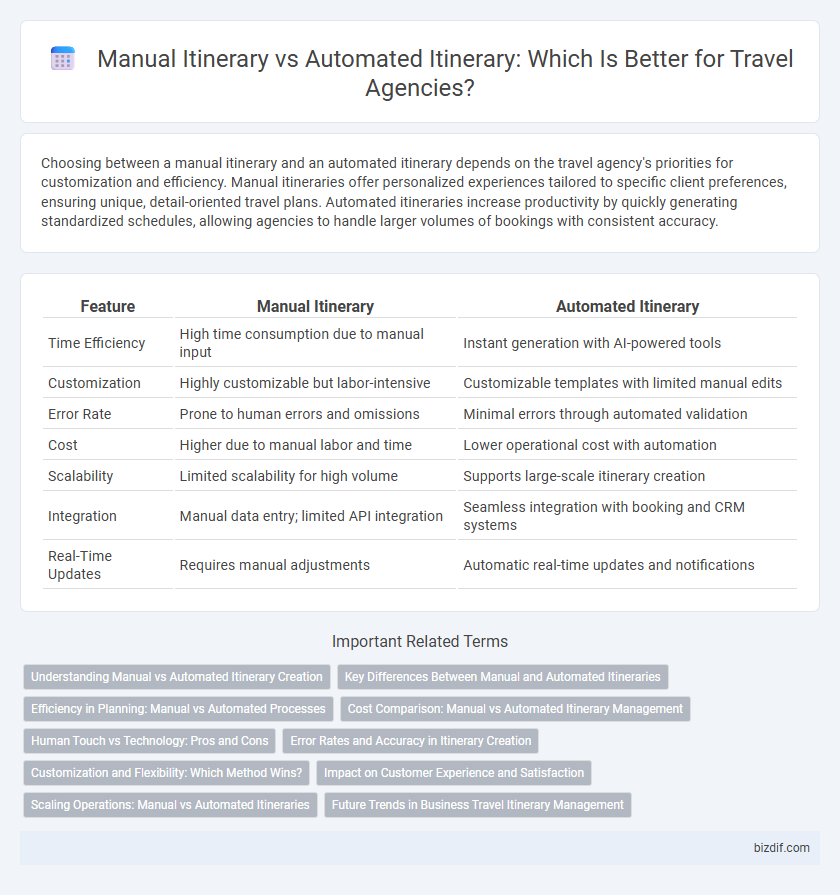Choosing between a manual itinerary and an automated itinerary depends on the travel agency's priorities for customization and efficiency. Manual itineraries offer personalized experiences tailored to specific client preferences, ensuring unique, detail-oriented travel plans. Automated itineraries increase productivity by quickly generating standardized schedules, allowing agencies to handle larger volumes of bookings with consistent accuracy.
Table of Comparison
| Feature | Manual Itinerary | Automated Itinerary |
|---|---|---|
| Time Efficiency | High time consumption due to manual input | Instant generation with AI-powered tools |
| Customization | Highly customizable but labor-intensive | Customizable templates with limited manual edits |
| Error Rate | Prone to human errors and omissions | Minimal errors through automated validation |
| Cost | Higher due to manual labor and time | Lower operational cost with automation |
| Scalability | Limited scalability for high volume | Supports large-scale itinerary creation |
| Integration | Manual data entry; limited API integration | Seamless integration with booking and CRM systems |
| Real-Time Updates | Requires manual adjustments | Automatic real-time updates and notifications |
Understanding Manual vs Automated Itinerary Creation
Manual itinerary creation allows travel agents to customize every detail based on personal knowledge and client preferences, ensuring a tailored travel experience. Automated itinerary generation utilizes algorithms and software to quickly assemble travel plans from a vast database, optimizing efficiency and consistency. Understanding the balance between personalized service and tech-driven speed is essential for delivering effective travel solutions.
Key Differences Between Manual and Automated Itineraries
Manual itineraries rely on personalized planning through human agents, offering tailored experiences but requiring more time and effort. Automated itineraries utilize software algorithms and AI to quickly generate travel plans, enhancing efficiency and consistency but sometimes lacking customization. Key differences include the speed of creation, level of personalization, and ease of modifications during the booking process.
Efficiency in Planning: Manual vs Automated Processes
Manual itinerary planning often requires extensive time and human effort to research, organize, and customize travel details, which can lead to inefficiencies and higher chances of errors. Automated itinerary processes leverage advanced software and AI algorithms to quickly generate optimized travel plans, reducing planning time by up to 70% and enhancing accuracy. The integration of automated tools enables travel agencies to streamline operations, improve client satisfaction, and handle larger volumes of bookings with consistent efficiency.
Cost Comparison: Manual vs Automated Itinerary Management
Manual itinerary management often incurs higher costs due to increased labor hours, human error risks, and the need for constant updates. Automated itinerary systems reduce expenses by streamlining booking processes, minimizing mistakes through real-time data integration, and enabling scalable service delivery at lower operational costs. Travel agencies adopting automated tools can achieve significant savings on administrative costs while enhancing customer satisfaction through faster and more accurate itinerary adjustments.
Human Touch vs Technology: Pros and Cons
Manual itineraries allow travel agents to tailor personalized experiences by leveraging local knowledge and client preferences, ensuring nuanced and flexible trip planning. Automated itineraries use advanced algorithms and real-time data to optimize routes, costs, and bookings, enhancing efficiency and scalability for bulk travel management. Human touch excels in emotional connection and bespoke customization, while technology provides speed, accuracy, and access to vast information, creating a balanced approach for effective travel planning.
Error Rates and Accuracy in Itinerary Creation
Manual itinerary creation in travel agencies often leads to higher error rates due to human oversight and inconsistent data entry, impacting the accuracy of booking details and travel schedules. Automated itinerary systems leverage algorithms and real-time data integration to minimize errors, ensuring precise coordination of flights, accommodations, and activities. Accurate itineraries enhance customer satisfaction by reducing the risk of booking conflicts and travel disruptions.
Customization and Flexibility: Which Method Wins?
Manual itineraries offer unparalleled customization and flexibility, allowing travel agents to tailor every detail to the client's unique preferences and last-minute changes. Automated itineraries, while efficient and quick, often rely on preset templates that limit personalization and adaptability during unforeseen circumstances. For travelers seeking a deeply personalized experience, manual planning remains the superior choice for flexibility and customization.
Impact on Customer Experience and Satisfaction
Manual itineraries offer personalized customization, allowing travel agents to tailor each detail according to unique customer preferences, which enhances satisfaction through bespoke experiences. Automated itineraries increase efficiency and accuracy by leveraging AI algorithms to quickly generate optimized travel plans, reducing human error and improving reliability. Combining manual customization with automated precision maximizes customer experience by delivering both personalized service and seamless execution.
Scaling Operations: Manual vs Automated Itineraries
Scaling operations becomes increasingly efficient with automated itineraries, as they streamline booking processes, reduce human error, and allow for rapid customization across multiple clients. Manual itineraries demand significant time and labor, limiting the number of clients served and increasing operational costs. Automated solutions integrate real-time data and customer preferences, enhancing scalability and improving overall productivity in travel agencies.
Future Trends in Business Travel Itinerary Management
Manual itineraries offer personalized customization but lack real-time updates and scalability crucial for modern business travel demands. Automated itineraries leverage AI-driven platforms and data analytics to provide dynamic, seamless adjustments and enhanced traveler experience. Future trends indicate widespread adoption of integrated digital ecosystems combining AI, machine learning, and predictive analytics to optimize itinerary management efficiency and cost-effectiveness.
Manual itinerary vs Automated itinerary Infographic

 bizdif.com
bizdif.com